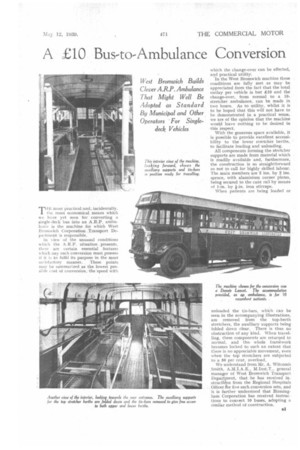,E10 Bus-to-Ambulance Conversion
Page 35

If you've noticed an error in this article please click here to report it so we can fix it.
West Bromwich Builds Clever A.R.P. Ambulance That Might Well Be Adopted as Standard By Municipal and Other Operators For Single
deck Vehicles
THE most practical and, incidentally. the most economical means which we have yet seen for converting a single-deck bus into an AR P. ambulance is the machine for which West 13roinwich Corporation Transport Department is responsible.
In view of the unusual conditions which the A.R.P. situation presents, there are certain essential features which any such conversion must possess if it is to fulfil its purpose in the most sal is factory manner. These points may be summarised as the lowest possil de cost of conversion, the 'speed with which the change-over can be effected, and practical utility.
In the West Bromwich machine these conditions are fully met as may be appreciated from the fact that the total outlay per vehicle is but £10 and the change-over, from normal to a 10stretcher ambulance, can be made in two hours. As to utility, whilst it is to be hoped that this will not have to he demonstrated in a practical sense, we are of the opinion that the machine would leave nothing to be desired in this 'respect.
With the generous space available, it is possible to provide excellent accessibility to the lower stretcher berths, to facilitate loading and unloading.
Al] components forming the stretcher supports are made from material which is readily available and, furthermore, the construction is so straightforward as not to call for highly skilled labour. The main members are 2 ins. by 2 ins. spruce, with aluminium corner plates, being secured to the cant rail by means of 1-in. by Fin. iron stirrups.
When patients are being loaded or
unloaded the tie-bars, which can be seen in the accompanying illustrations, are removed from the top-berth stretchers, the auxiliary supports being folded down clear. There is thus no obstruction of any kind. When travelling, these components are returned to normal, and thewhole framework becomes locked to such an extent that there is no appreciable movement, even when the top stretchers are subjected to a 50 per cent. overload.
We understand from Mr. A. Witcomb Smith, A.M.I.A.E., M.Inst.T., general manager of West Bromwich Transport Departinent, that he has received instructiclns from the Regional Hospitals Officer. An five such conversion sets, and it is further understood that Birmingham Corporation has received instructions to convert 10 buses, adopting a similar method of construction.














































































